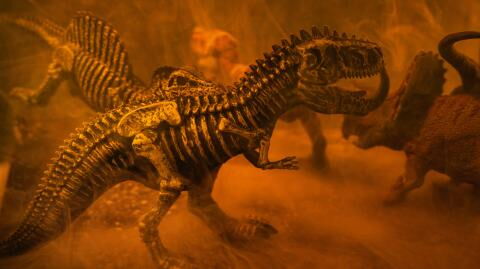66 million years ago, an asteroid crashed through the Earth's atmosphere. This devastating impact and the period that followed, known as the K-Pg (Cretaceous-Paleogene extinction, with its succession of firestorms, megatsunamis and nuclear winter), put a definitive end to the 180-million-year reign of the dinosaurs, and more broadly to the 75% of living species that inhabited the Earth at the time.
Discover our latest podcast
Today, species such as tyrannosaurus rex, diplodocus and velociraptor can only be seen in museums. But one species continues to outlive them: flowering plants (or angiosperms). So, if you go out and buy roses, for example, you'll be in the presence of ancient lines that flowered on the ashes of K-Pg.
Living species that evolved during the K-Pg period
Although the living species of roses are not the same as those that shared the Earth with Tyrannosaurus, their lineage (Rosaceae family) was born tens of millions of years before the asteroid impact. And this lineage is not an isolated case.
Indeed, fossils and genetic analyses suggest that the vast majority of these families were born before the asteroid: the ancestors of the ornamental orchid, magnolia and passionflower, grass and potato, medicinal daisy and spearmint families also shared the Earth with the dinosaurs.
According to Jamie Thompson, author of the scientific publication Postdoctoral Evolutionary Biologist and Professor at the University of Bath (England) in the Department of Life and Earth Sciences, the explosive evolution of this plant family, which has given rise to some 290,000 species today, may even have been facilitated by the K-Pg period.
An unfailing ability to adapt
However, it's difficult to answer the main question: how did they survive, when so fragile compared to the dinosaurs? According to scientific studies, the resistance of flowering plants to mass extinction during the K-Pg period can be explained by their capacity to adapt.
For example, the evolution of new seed dispersal and pollination mechanisms. They can also duplicate their entire genome (all the DNA instructions of an organism), providing a second copy of each gene on which natural selection can act.
Thanks to their extraordinary capacity for evolution and adaptation, these plants could well survive the next mass extinction.
This Ancient Life-Form Outlasted The Dinosaurs, And It May Bury Us Too https://t.co/a5LCiWhWy8
— ScienceAlert (@ScienceAlert) September 17, 2023
This article has been translated from Gentside FR.
Read more:
⋙ This popular dinosaur might have been as smart as a primate, according to study
⋙ Fossils discovered on Scottish Island indicate that this species is older than people think
Sources used:
Science Alert: This Ancient Life-Form Outlasted The Dinosaurs, And It May Bury Us Too















